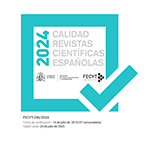La etapa inmanente de la Estética de Buenaventura desde sus fuentes de inspiración
Resumen
De entre el ingente corpus teórico del pensador franciscano Buenaventura de Bagnoregio, hemos focalizado aquí nuestra atención sobre el libro titulado Itinerarium mentis in Deum (1259), porque en él nuestro autor condensa el núcleo esencial de su peculiar Estética. Restringiendo aún más el enfoque investigador, en el presente artículo nos limitamos a analizar la primera de las tres fases o niveles en que Buenaventura estructura su Estética, a saber, la fase que podríamos denominar Estética inmanente. En ella, según el autor, el ser humano puede llegar al conocimiento de Dios, si considera los seres materiales como vestigios e imágenes bellas que reflejan visiblemente la invisible belleza divina. En la segunda parte de nuestro artículo, intentamos poner en evidencia algunas tesis de filósofos precedentes que parecen haber inspirado casi con certeza a San Buenaventura en los enunciados básicos de su Estética inmanente.
Descargas
Descarga artículo
Licencia
La Revista de Filosofía, para fomentar el intercambio global del conocimiento, facilita el acceso sin restricciones a sus contenidos desde el momento de su publicación en la presente edición electrónica, y por eso es una revista de acceso abierto. Los originales publicados en esta revista son propiedad de la Universidad Complutense de Madrid y es obligatorio citar su procedencia en cualquier reproducción total o parcial. Todos los contenidos se distribuyen bajo una licencia de uso y distribución Creative Commons Reconocimiento 4.0 (CC BY 4.0). Esta circunstancia ha de hacerse constar expresamente de esta forma cuando sea necesario. Puede consultar la versión informativa y el texto legal de la licencia.












